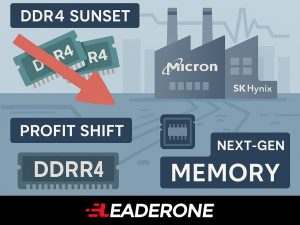
Infographic showing Micron phasing out DDR4 memory with market trends and next-gen memory focus.
Boise, ID – A significant shift is underway in the memory market. Micron Technology is ending its DDR4 production. This aligns with moves by other major manufacturers like Samsung and SK Hynix. This decision marks a major turning point. It signals a push towards next-generation memory. The Micron DDR4 phase out next steps will reshape the memory industry.
The end of DDR4 production comes despite strong, unexpected demand. This is creating supply gaps. Yet, top memory makers are focusing on more advanced, profitable technologies.
Why DDR4 is Being Phased Out
Several factors are driving Micron’s decision to discontinue DDR4:
- Profitability Challenges: Chinese memory manufacturers are flooding the market. They offer lower-cost DDR4 alternatives. This makes DDR4 less profitable for established players.
- Focus on Next-Gen Memory: Major companies want to shift resources. They are prioritizing higher-margin products. These include DDR5, LPDDR5, and High Bandwidth Memory (HBM). These newer technologies offer better returns on investment.
- Technological Advancements: Newer memory standards provide significant performance gains. They also offer better energy efficiency. These features are crucial for modern computing needs.
Micron Chief Business Officer Sumit Sadana noted rising DDR4 spot prices. These sometimes exceed newer DDR5 products. Despite this, the company urges customers to upgrade.
What Comes Next for the Memory Industry
The Micron DDR4 phase out next steps highlight the future of memory. The industry is rapidly transitioning to more advanced solutions:
- DDR5 Dominance: DDR5 is becoming the new standard for PCs and servers. It offers higher bandwidth and improved power efficiency. Prices for DDR5 are now competitive.
- LPDDR5/LPDDR5X for Mobile and AI: For smartphones and AI-powered edge devices, LPDDR5X is key. Micron, for example, is sampling 1γ (1-gamma) node-based LPDDR5X. It’s thinner, faster (up to 10.7Gbps), and more energy-efficient (20% power savings). This is crucial for AI acceleration in 2026 flagship phones.
- High Bandwidth Memory (HBM): HBM is vital for AI data centers and high-performance computing. It offers massive bandwidth for AI accelerators. All major memory makers are ramping up HBM production.
- Future Standards (DDR6 and Beyond): Research and development for DDR6 are already underway. This next standard will bring even higher speeds and greater efficiency. It promises speeds of up to 14.4Gbps and 50% better energy efficiency than LPDDR5X.
The memory industry is moving towards a future demanding speed, efficiency, and specialized solutions. While DDR4 served its purpose, the needs of AI, cloud computing, and advanced mobile devices require more. This shift ensures continuous innovation and performance gains across the technology landscape.
